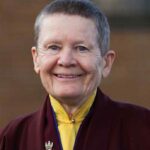Buddhist meditation is about dissolving our fixation on ourselves, on the process of meditating, and on any result we might gain from it. Through meditation, we begin to get the hang of living with a non-grasping attitude.
When you sit down to meditate, you can bring to your practice the notion of the threefold purity: not being caught up with ideas about yourself, not being caught up with ideas about the practice, and not being caught up with ideas about the result.
You have to start where you are.
Sometimes you begin meditation with the sense, I am sitting down to meditate. That’s not too helpful. However, you can’t just click your fingers and Zap!—all sense of self is gone. You have to start where you are. Before you sit down you can actually reflect on the fact that you don’t have to hold on to a solid identity of yourself as a worthless or worthy person, as someone who can’t meditate, or as someone who can. You can practice lightening up the whole persona that you bring to meditation.
For example, if you’re new at it, you might take a certain pride in being a meditator. You come back from a retreat and your friends say, “Where were you?” and you say, “Oh, I was just meditating for ten days in a monastery on Cape Breton Island. We kept silence most of the time and we meditated many, many hours every day.” You have this feeling, “Wow! Are they going to be impressed.” Perhaps in other situations you feel a little embarrassed. If your parents ask you where you were, you might say, “Oh, I just went on a little trip to Cape Breton.”
To begin with, just give up any expectations of yourself. That’s a simple good instruction for how to meditate. Liberate yourself from any sort of idea of how you’re supposed to be, and just sit. Then remember this instruction occasionally during the meditation period, because you’re going to do a lot of talking to yourself about how right or how wrong you are. You’re going to spend a lot of time on center stage as the star of your own movie. You can spend a lot of time planning, worrying, and trying to get it all right.
The changes go on and on. Observe them with no expectation of how you’re supposed to be, or who you are.
Instead of holding on to a limited identity of yourself, do your best to observe yourself minute after minute. Observe what’s happening. You’ll keep freezing it by fixating on it, because you do have an idea of who you are; we all have an idea of who we are. But if you’ll just observe instead of fixating, the meditation itself will begin to shake that identity up a lot. You’ll begin to have doubt about being just one way; you’ll see that who you are and how you are keep changing. The first five minutes of the meditation period you’re depressed; the gong rings and you feel happy. In walking meditation you’re bored; you sit down on your cushion again and your back hurts. The gong rings and you realize you’ve been on a shopping spree in New York City. The changes go on and on. Observe them with no expectation of how you’re supposed to be, or who you are. Just sit there and see what happens.
That’s the first quality of threefold purity. Traditionally it’s stated as “no self.” What it points to is giving up expectations of being any particular way. Buddhist meditation is the perfect vehicle for seeing how you keep changing, changing, changing. Thoughts keep changing. Emotions keep changing. They say that advanced meditators can even see molecules changing. (Personally I’ve never had this experience.)
The second guideline of the threefold purity is “No meditation.” Don’t make your meditation a project or a special event; don’t bring into it an attitude of great seriousness and solemnity. For that matter, have no concept of your meditation at all, no religiosity. Don’t hold any notions about it, not even, “Oh, meditation is meant to be completely natural; you just sit down, relax the mind, and be cool.”
That’s the whole training — to let go and observe without judgment.
We have a lot of ideas about what’s good meditation, what’s bad meditation. The notion here is that we sit down with no expectations of ourselves and no expectations of what the practice is. We simply follow the instructions, without imagining that meditation is supposed to be this way or that way. We can continuously let go of any solid views on the meditator or the meditation, any caught-upness. That’s the whole training—to let go and observe without judgment, without bias. We can just let go.
So you think, “That’s the meditation. I’m supposed to observe and let go. But I can’t observe and I can’t let go, and my meditation is a mess. On the other hand, I did observe a little bit, and that’s good. If I have a chance to tell my meditation instructor about this, she’ll be pleased.” We have a habitual tendency to solidify, but remember these instructions: no Expectations. It is as it is. You don’t have to add something extra.
The third quality of threefold purity is “No result.” Give up all hope of fruition. Practice without hope of anything beyond right now. That’s all there is; there’s no later. Being on the spot is the only way any transformation of your being occurs. If you practice with hope and fear, if you practice in order to become what you think you should be—even a calmer, more loving, more compassionate person—you’re just setting yourself up for disappointment. You can’t get there from here. Being fully here for each moment—that’s the point, from now until you die.
After you’ve meditated, if you notice something that feels like a result—for example, your mind feels rested, or you feel completely one-pointed, or you feel a lot of compassion or kindness—simply observe it and let it go. Trungpa Rinpoche often used the word “disown.” It’s not that there’s anything wrong with results. But when we cling to results, they’re of no use at all. One of the mahamudra texts says, “Even the qualities of clarity, non-dwelling, and bliss are obstacles if you cling to them.”
So that’s threefold purity. It provides good directions for practicing meditation—or any other activity, for that matter. Have no expectation about who you are—the generous one or the mean one or whoever—no expectation of your activity or process, no expectation of fruition. This is how we go from living by concept, freezing ourselves in time and space, to relaxing into the fluid spaciousness with which we were born.

